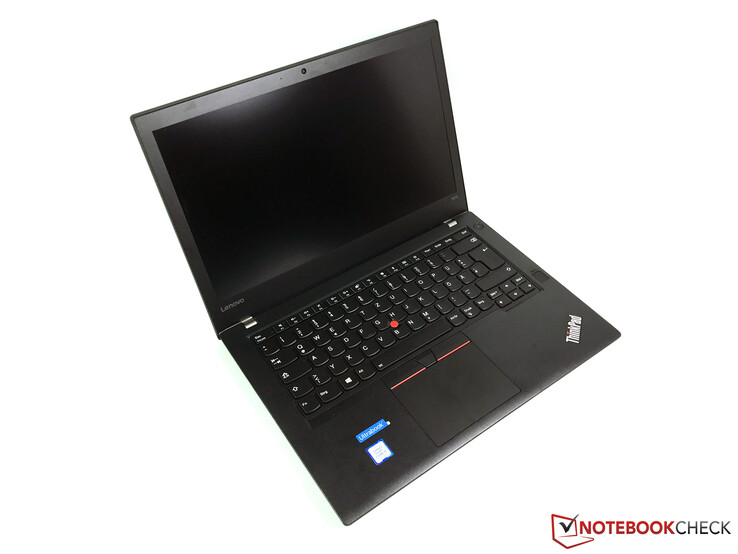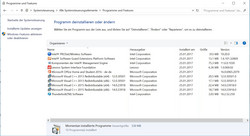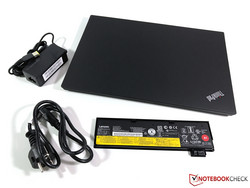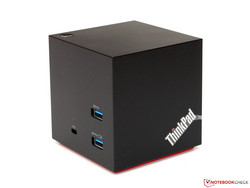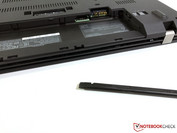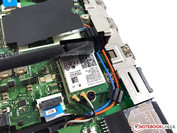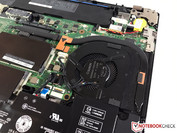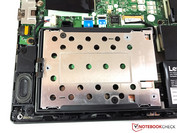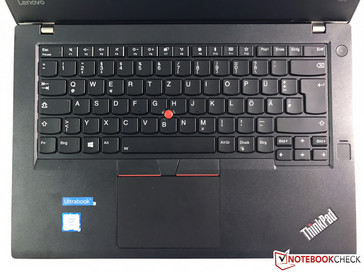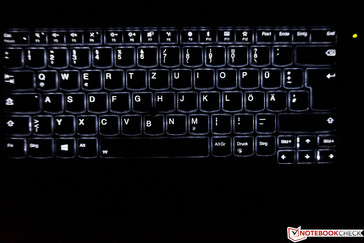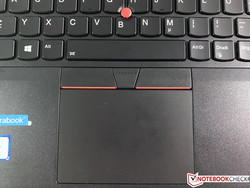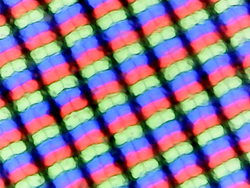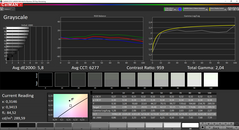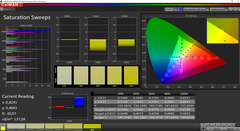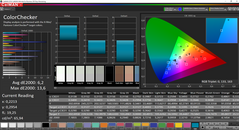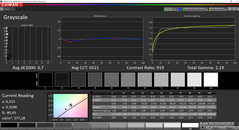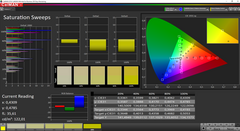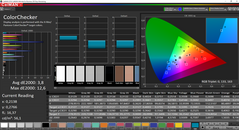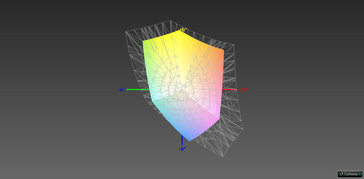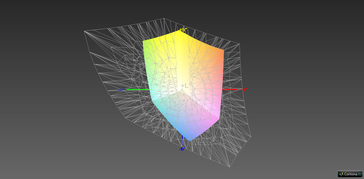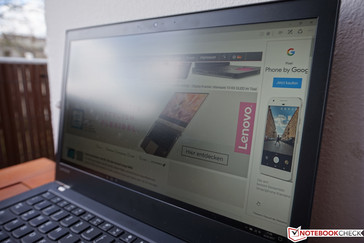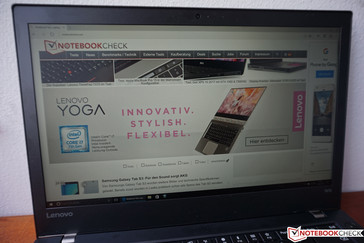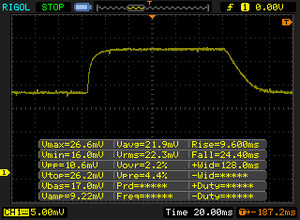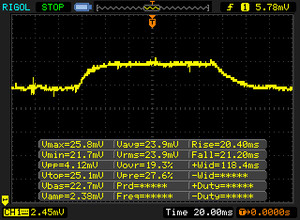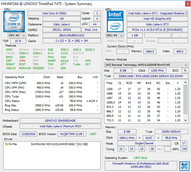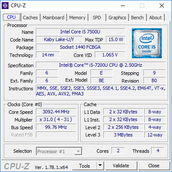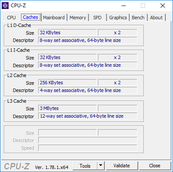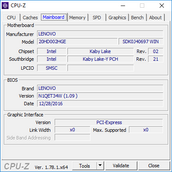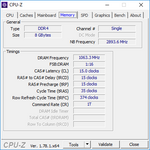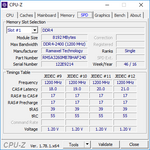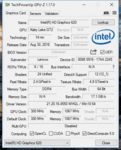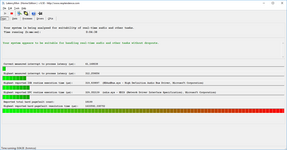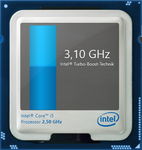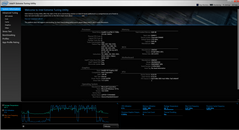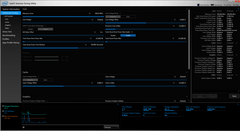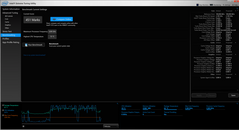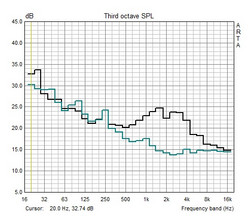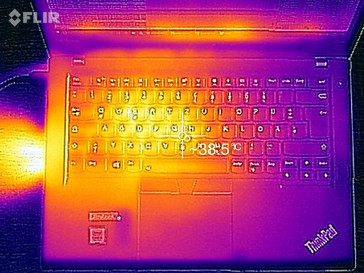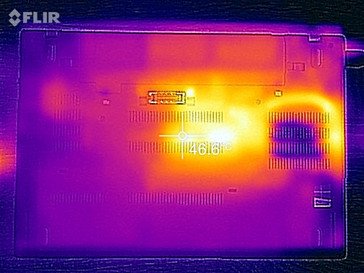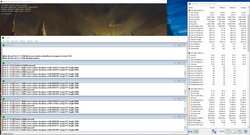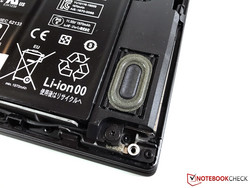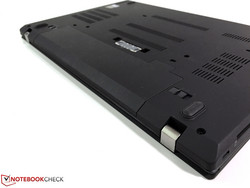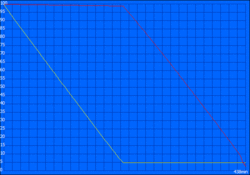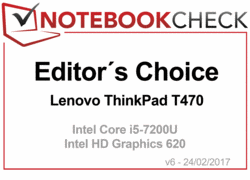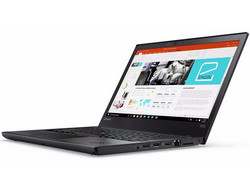Lenovo ThinkPad T470 (Core i5, Full-HD) Notebook Review

For the original German review, see here.
Lenovo's updated business lineup hardly offers any surprises this year. Many models only got the Kaby Lake update, but most series still use the same chassis. One exception is the "standard" T-series – both the 14-inch ThinkPad T470 as well as the 15.6-inch T570. It is the first time since the Tx40-series three years ago that they get a new case, which is slightly smaller and lighter. The 14-inch model might even be capable of reducing the gap to the T470s (no changes for the case).
Our test model is the ThinkPad T470 20HD002HGE for 1,640 Euros with a modern Kaby Lake Core i5-7200U, 8 GB RAM, a 512 GB NVMe-SSD as well as a matte Full HD IPS panel. The security equipment is as comprehensive as ever and Lenovo now also includes a full-fledged Thunderbolt 3 port with a USB Type-C connector. The campus model (for students and teachers) of our test model has the designation 20HES01100 and is much more affordable at 1,200 Euros.
Rivals are high-quality business notebooks from the other big manufacturers. The list includes the HP EliteBook 840 G4, the Dell Latitude E7480 as well as the Fujitsu LifeBook U747, for example. However, we could not yet review all of them yet or they are currently in review, so we will also include some of the predecessors for our comparison. The ThinkPad T470s is definitely an interesting comparison device as well, so we will also include the similarly constructed T460s.
Update February 26th: Luminance on battery power
Case
We have already mentioned that the ThinkPad T470 is one of the few new laptops from Lenovo with a new chassis this year. The dimensions (also see size comparison below) hardly changed, but you can still easily distinguish the new T470 from its predecessor. The Chinese manufacturer now once again uses a black chassis and waives the dark gray color scheme.
The system leaves a very dense impression and the base unit is very stable. Pressure is no problem for the carbon-fiber reinforced plastic chassis, only the area left next to the touchpad contacts the surface beneath, which results in a slight clattering noise. Twisting attempts only result in minor creaking as well. The thin lid cannot quite keep up in this respect. The lower bezel in particular can easily be twisted, which results in picture distortions. Pressure from behind on the other hand is no problem and twisting attempts once again only result in minor creaking. The two metal hinges are very firm and basically prevent bouncing completely, but you have to use both hands to open the lid in return. The maximum opening angle is – as usual – 180 degrees.
Overall, both the stability and the build quality are very good, but, which is no surprise, not quite on par with high-quality unibody metal constructions. One advantage of the T470, however, is the external battery (total of two batteries), which is easily accessible at the back. It is located in the center and does not have a support foot, so the device is very stable on a desk even when you remove the battery. There are no dedicated maintenance hatches, but you can remove the whole bottom cover to access the components (more on that later).
Connectivity
Lenovo also used the new chassis to update the ports and relocate some of them. The SIM tray (micro-SIM) is now once again inside the battery tray at the back, for example. The most important change compared to the previous model is the implementation of the Thunderbolt 3 port, which is also a USB Type-C port (Gen2) that can be used for charging (Power Deliver 2.0). TB3 is extremely versatile and therefore future-proof; the supported protocols also include DisplayPort 1.2a, for instance. The latter can drive high-resolution 4K screens at 60 Hz; the HDMI 1.4 output only supports 4K at 24 Hz. VGA monitors, which are still common in some companies, require an adapter (not provided).
Lenovo uses the available space at both sides of the chassis very well and also implements three regular USB 3.0 ports (USB 3.1 Gen1, 1x always-on), one RJ45 Ethernet, a full SD-card reader as well as a SmartCard reader. Dedicated docking stations (previous models still compatible) can be attached via docking port at the bottom. We really like the layout – all ports are at the sides towards the back and there is enough room between the individual ports. The performance of the regular USB ports is good; we measured more than 380 MB/s in combination with our external Samsung SSD T3.
SD-Card Reader
The SD-card reader (UHS-I) at the right side takes the memory card completely and could therefore be used for permanent storage expansion. We can determine a maximum transfer rate of almost 90 MB/s (AS SSD) in combination with our reference card from Toshiba (Exceria Pro SDXC UHS-II 64 GB, up to 260 MB/s). Pictures (.jpeg, ~5 MB each, total of 1 GB) are transferred at almost 77 MB/s. These are average results, but a faster card reader could manage much higher results.
| SD Card Reader | |
| average JPG Copy Test (av. of 3 runs) | |
| Lenovo ThinkPad T470-20HD002HGE | |
| Lenovo ThinkPad T460s-20F9003SGE | |
| maximum AS SSD Seq Read Test (1GB) | |
| Lenovo ThinkPad T470-20HD002HGE | |
| Lenovo ThinkPad T460s-20F9003SGE | |
Communication
Besides the integrated Gigabit controller (Intel I219V) for wired networks, you can obviously use wireless networks as well. Lenovo offers several adapters; our test model is equipped with the Intel Dual-Band Wireless-AC 8265. The name already suggests that it is a dual-band module (2x2, 2.4 & 5 GHz) with a maximum transfer rate of 867 Mbps. All modern WiFi standards including the fast 802.11ac as well as Bluetooth 4.2 are supported. The Intel module actually supports the faster 4.2 standard, but the operating systems limits it to 4.1 according to Lenovo. The optional Tri-Band Wireless-AC 18265 WiFi module from Intel (2x2, WiGig 802.11ad) is an interesting option, which is required for the wireless docking station. More information about the latter is available in the "Accessories" section.
Our standardized WLAN test with the router Linksys EA8500 (1m distance) determines very good results for our test models. We can see 657 Mbps receive and 512 Mbps send, so the T470 is one of the faster systems in this respect and it can also beat the smaller sibling ThinkPad E470. Only Apple's new MacBook Pro models are noticeably faster. We tested the ThinkPad T470 with different routers during our review period (Fritz!Box 7490 & Asus RCT-AC56U) and there were no problems in terms of performance or stability.
| Networking | |
| iperf3 transmit AX12 | |
| Apple MacBook Pro 15 2016 (2.6 GHz, 450) (Klaus I211) | |
| Lenovo ThinkPad T470-20HD002HGE | |
| Lenovo ThinkPad E470-20H2S00400 | |
| iperf3 receive AX12 | |
| Apple MacBook Pro 15 2016 (2.6 GHz, 450) (Klaus I211) | |
| Lenovo ThinkPad T470-20HD002HGE | |
| Lenovo ThinkPad E470-20H2S00400 | |
The ThinkPad is also available with an optional WWAN module. Lenovo offers two different models: Intel XMM 7160 (Fibocom L831-EAU, 4G LTE) and Qualcomm Snapdragon X7 LTE-A (Sierra Wireless EM7455). It is also possible to upgrade a corresponding module after the purchase since all the necessary antennas are already prepared. The WWAN module uses the M.2-2242 slot, so you cannot use an additional SSD (M.2-2242) in this case. WWAN and WiGig are compatible. The ThinkPad T470 also supports NFC, but it was not available on our test model.
Nothing changed in terms of the HD webcam. There were hardly any advancements in terms of picture quality over the last couple of years. The module is still sufficient for video calls. The dual-array microphone above the display leaves a much better impression and convinces with clear voice recordings.
Security
The security equipment of the ThinkPad T470 is very comprehensive and we do not miss anything. It starts with the comprehensive BIOS, where you can set up different passwords and configure all ports individually. Lenovo also implements a Trusted Platform Module (TPM 2.0) and Computrace is supported as well.
You can protect the Windows login with a standard password, a SmartCard or the fingerprint scanner. Contrary to the old ThinkPad T460, Lenovo now implements a very comfortable touch scanner, where you just have to put your finger on it. The works very quickly and reliably in practice. Facial recognition via camera is not supported.
Software
Lenovo already announced that some new ThinkPad models will be shipped with the so called Windows Signature edition. This is also the case for our test model, because there is no bloat ware except for two system tools (also see screenshot). Windows itself still has the usual additions like a trial version of Office 2016 or links for games, but you can remove them quickly.
Accessories
The box of the Lenovo ThinkPad T470 only includes the notebook itself, a 45-Watt power adapter, the external 3-cell battery and some service brochures. Lenovo offers a number of dedicated accessories. Particularly interesting are the larger batteries. They increase the weight of the laptop and also lift it a bit at the rear, but you can basically double the runtimes with the 72-Wh model.
The integration into productive environments via docking stations is another important aspect, and there are multiple solutions. For starters, there is obviously the Thunderbolt 3 port and Lenovo offers two corresponding solutions (170-270 Euros). Then there is also the dedicated docking port at the bottom. The big advantage is the compatibility with previous products (all the way back to the T440), so you do not necessarily need new hardware. Lenovo offers different models in a price range between 130-200 Euros.
The last method is the wireless docking station ThinkPad WiGig Dock. However, the notebook has to be equipped with a corresponding WiFi module like the optional Intel Wireless-AC 18265 in the case of the ThinkPad T470. The dock is not a bargain at 300 Euros, though, and there are also other drawbacks. We already had the chance to test the ThinkPad WiGig Dock in combination with the ThinkPad T460s last year. More information is available in the corresponding review.
Maintenance
Accessing the components requires the removal of the whole bottom panel. You have to loosen 6 small Philips screws (attention: only loosen, not remove!) before you can pry open the panel. We recommend you use a corresponding tool and start at the back and then work your way to the front.
Once inside, you can see some advantages compared to modern consumer Ultrabooks, because only the processor is soldered onto the mainboard. There are two SODIMM slots, but only one slot of our test model is equipped with an 8 GB module (DDR4-2400). Between the WiFi module and the 2.5-inch slot is also a free M.2-2242 slot, which can either be used for a WWAN module (antennas prepared) or an SSD. The NVMe-SSD (M.2-2280) of our test model is sitting in the 2.5-inch tray via adapter. The fan, CMOS battery, and the internal battery can be accessed as well.
Warranty
The ThinkPad is shipped with a three-year warranty by default, which also includes an on-site service on the next business day. The battery, however, is only covered for one year. It is possible to extend the warranty period and also expand the service. An upgrade to 5 years retails for around 150 Euros; with additional accidental protection around 320 Euros.
Please see our Guarantees, Return Policies and Warranties FAQ for country-specific information.
Input Devices
Keyboard
Lenovo equips all ThinkPads with good keyboards, but the models from the P- and T-series usually get the best models. Lenovo obviously did not change anything compared to the old ThinkPad T460, which is not a bad thing. The black chiclet keyboard is still on of the best inputs in the mobile segment. Feedback and key stroke are great and frequent writers will be very happy with the slightly concave keys. Another advantage – also over the slightly thinner ThinkPad T460s and the ThinkPad X1 Carbon – is the comparatively long key travel.
We also like the typing noise in general, only larger keys like Return or the space bar create a slightly louder noise. As per usual for ThinkPads, the layout differs a bit from the standard, but you can swap Fn and Ctrl in the BIOS. The F-keys trigger additional features (like brightness control, volume etc.) by default, which can either be changed via FnLock (Fn+Esc) or in the BIOS.
Lenovo still implements a white two-stage keyboard illumination. This makes typing in dark environments much easier, but we would have liked to see a brighter third level.
Touchpad
Lenovo equips the new ThinkPads with so-called Precision Touchpads. This means inputs are directly handled by the operating system and not by a third-party driver. You can still find the Synaptics control panel in the settings, but the functionality was heavily reduced compared to previous models. You can only adjust the sensitivity and the palm rejection. It is also possible to set up a zone at the edges where clicks are not recognized. All other settings, like the gestures configuration, for example, is limited to the Windows settings from now on.
The smooth ClickPad from Synaptics is sufficiently sized at 10 x 7 cm and works very well. It provides good gliding capabilities, inputs are recognized reliably and the mouse replacement also handles gestures very well. The dedicated mouse buttons (lower half of the pad can be clicked) execute clicks reliably, but they are a bit loud. The touchpad is firmly integrated into the palm rests and there is no clattering.
The TrackPoint with three dedicated mouse buttons above the touchpad is also available for cursor movements. It works as well as ever and the buttons accept clicks over the whole width. Only the clicking noise was not perfect. The left button is conveniently quiet, but we could hear the right button on our test model. All in all, however, this is moaning on a high level.
Display
According to the specifications, Lenovo offers different panels for the ThinkPad T470. The HD panel (1366 x 768 pixels) is already advertised with low values for the luminance (220 nits) and the contrast (400:1), so you should avoid it. Most models will probably be equipped with the matte Full HD IPS screen (touch optional), which is also the case for our test model.
We already know the panel with the designation N140HCA-EAB from the ThinkPad E470, but our measurements show some differences, especially in terms of the luminance. We determine a good average value of 287 nits (up to 306 nits). but only when the PSU is attached. Once you detach the power adapter, the maximum luminance drops to ~250 nits. This is probably to save power, but it is annoying for a portable device like the T470. We did not find any option in the BIOS or the power settings to change this behavior. The removal of the Lenovo Settings app did not help, either. An upcoming BIOS update might help, but there was no update at the time of the review.
Update February 26th: Further tests showed that the display luminance on battery changes depending on the picture content. You an see a slight step-wise decrease when you look at darker contents in particular. The Intel drivers turned out to be the problem. The two options "Improved Power-Saving mode" and "Display-Refresh Rate" in the global settings have to be deactivated (for each profile). These options are not new, but they were never active on the ThinkPads we tested so far. The maximum luminance is now also available on battery power.
The black value is also very good at 0.3 cd/m², which has a positive effect on the contrast ratio (1000:1) as well. Subjectively, we like the picture and the Full HD resolution is a good fit for the 14-inch panel (157 PPI). There is only minor backlight bleeding, but it is not annoying. We could not detect PWM flickering.
| |||||||||||||||||||||||||
Brightness Distribution: 88 %
Center on Battery: 304 cd/m²
Contrast: 1020:1 (Black: 0.3 cd/m²)
ΔE Color 6.2 | 0.5-29.43 Ø5
ΔE Greyscale 5.8 | 0.57-98 Ø5.3
61.44% sRGB (Argyll 1.6.3 3D)
39.62% AdobeRGB 1998 (Argyll 1.6.3 3D)
43.06% AdobeRGB 1998 (Argyll 2.2.0 3D)
61.9% sRGB (Argyll 2.2.0 3D)
41.6% Display P3 (Argyll 2.2.0 3D)
Gamma: 2.04
| Lenovo ThinkPad T470-20HD002HGE N140HCA-EAB, , 1920x1080, 14.00 | Lenovo ThinkPad T460-20FN003LGE Lenovo LEN40A9 / N140HCE-EAA, , 1920x1080, 14.00 | Lenovo ThinkPad T460s-20F9003SGE N140HCE-EAA, LEN40A9, , 1920x1080, 14.00 | Dell Latitude 14 7000 Series E7470 AUO B140QAN Dell PN F0WXVV, , 2560x1440, 14.00 | Lenovo ThinkPad E470-20H2S00400 N140HCA-EAB, , 1920x1080, 14.00 | |
|---|---|---|---|---|---|
| Display | 1% | 0% | 59% | -1% | |
| Display P3 Coverage | 41.6 | 42.09 1% | 41.65 0% | 67.2 62% | 41.23 -1% |
| sRGB Coverage | 61.9 | 62 0% | 61.6 0% | 95.9 55% | 61.4 -1% |
| AdobeRGB 1998 Coverage | 43.06 | 43.6 1% | 43.14 0% | 69.3 61% | 42.67 -1% |
| Response Times | 13% | 7% | 3% | 7% | |
| Response Time Grey 50% / Grey 80% * | 41.6 ? | 42.4 ? -2% | 42 ? -1% | 48 ? -15% | 40.8 ? 2% |
| Response Time Black / White * | 34 ? | 24.8 ? 27% | 29.2 ? 14% | 27 ? 21% | 30.4 ? 11% |
| PWM Frequency | |||||
| Screen | -12% | -5% | 33% | -10% | |
| Brightness middle | 306 | 230 -25% | 226 -26% | 380 24% | 244 -20% |
| Brightness | 287 | 216 -25% | 211 -26% | 354 23% | 231 -20% |
| Brightness Distribution | 88 | 85 -3% | 89 1% | 81 -8% | 89 1% |
| Black Level * | 0.3 | 0.26 13% | 0.22 27% | 0.26 13% | 0.37 -23% |
| Contrast | 1020 | 885 -13% | 1027 1% | 1462 43% | 659 -35% |
| Colorchecker dE 2000 * | 6.2 | 7.32 -18% | 6.44 -4% | 3.11 50% | 6.41 -3% |
| Colorchecker dE 2000 max. * | 13.6 | 18.14 -33% | 17.18 -26% | 6.73 51% | 13.4 1% |
| Greyscale dE 2000 * | 5.8 | 6.98 -20% | 5.87 -1% | 4.35 25% | 5.94 -2% |
| Gamma | 2.04 108% | 2.5 88% | 2.37 93% | 2.37 93% | 2.28 96% |
| CCT | 6277 104% | 6683 97% | 6856 95% | 6771 96% | 6101 107% |
| Color Space (Percent of AdobeRGB 1998) | 39.62 | 39.97 1% | 39.58 0% | 62 56% | 39.3 -1% |
| Color Space (Percent of sRGB) | 61.44 | 61.55 0% | 61.15 0% | 96 56% | 61.1 -1% |
| Total Average (Program / Settings) | 1% /
-6% | 1% /
-3% | 32% /
34% | -1% /
-6% |
* ... smaller is better
One drawback of the screen is – similar to the ThinkPad E470 – the color accuracy. Our measurements with the X-Rite i1Pro 2 spectrophotometer and the professional software CalMAN determine average DeltaE-2000 deviations of 5.8 (grayscale) and 6.2 (colors) compared to the sRGB reference ex-works. The deviations for the blue colors are particularly high (up to 13.6).
A calibration improves the results and helps the grayscale in particular, because the average DeltaE-2000 deviation drops to just 0.7. The slightly warm color temperature is now also very close to the ideal value of 6500 Kelvin, which is also the case for the Gamma value (ideal: 2.2). Only the improvements for the colors are limited, and the outliers for the blue colors are still visible. Our calibrated .icc profile is linked in the box above and can be used for free.
That the color accuracy is lower at higher saturation levels is also associated with the low color gamut. We can only determine 61% sRGB and 39% AdobeRGB, respectively. This is obviously sufficient for common office tasks, but the panel is not suited for professional picture editing. Presuming Lenovo does not change it strategy, you will have to get the WQHD models of the T470s or X1 Carbon (almost full sRGB coverage) for this scenario.
The ThinkPad T470 is not perfect outdoors. The matte screen helps reducing annoying reflections, but we already mentioned that the laptop reduces the maximum luminance on battery power. This is no problem on overcast days, but it is quickly tiring for the eyes in brighter environments or under sunlight.
Update February 26th: The combination of maximum luminance (also on battery, see above) and matte display surface works well outdoors. There are no limitations when you use the ThinkPad T470 on cloudy days, but we would have liked a higher luminance for very bright environments, because it will be tiring for the eyes.
Display Response Times
| ↔ Response Time Black to White | ||
|---|---|---|
| 34 ms ... rise ↗ and fall ↘ combined | ↗ 9.6 ms rise | |
| ↘ 24.4 ms fall | ||
| The screen shows slow response rates in our tests and will be unsatisfactory for gamers. In comparison, all tested devices range from 0.1 (minimum) to 240 (maximum) ms. » 89 % of all devices are better. This means that the measured response time is worse than the average of all tested devices (21.5 ms). | ||
| ↔ Response Time 50% Grey to 80% Grey | ||
| 41.6 ms ... rise ↗ and fall ↘ combined | ↗ 20.4 ms rise | |
| ↘ 21.2 ms fall | ||
| The screen shows slow response rates in our tests and will be unsatisfactory for gamers. In comparison, all tested devices range from 0.2 (minimum) to 636 (maximum) ms. » 62 % of all devices are better. This means that the measured response time is worse than the average of all tested devices (33.7 ms). | ||
Screen Flickering / PWM (Pulse-Width Modulation)
| Screen flickering / PWM not detected | ||
In comparison: 53 % of all tested devices do not use PWM to dim the display. If PWM was detected, an average of 17924 (minimum: 5 - maximum: 3846000) Hz was measured. | ||
Performance
Lenovo equips the ThinkPad T470 with modern ULV processors and (optional) fast SSDs, so the business laptop is suited for many usage scenarios. The manufacturer also offer models with the dedicated GeForce 940 MX graphics card (2 GB GDDR5-VRAM), but it will probably not be available in all countries. Our test model is one of the fastest SKUs thanks to the fast NVMe-SSD, and also offers a much better subjective performance impression compared to HDD-only systems.
Processor
The Core i5-7200U is Intel's bread and butter CPU in the mobile segment. The base frequency of the dual-core chip is 2.5 GHz, but the cores can reach up to 3.1 GHz (one and two active cores) via Turbo Boost and the chip can execute up to four threads thanks to Hyper Threading. Intel still manufacturers the Kaby Lake processor in a 14 nm process, but the efficiency was improved compared to Skylake thanks to several optimizations.
The ThinkPad T460s from last year was the first model where Lenovo removed the usual TDP limitation at 15 Watts and allowed a continuous consumption of up to 25 Watts for the CPU. This is also the case here, so the processor can always utilize its full Turbo Boost potential. This is particularly interesting for the optional Core i7, because the Core i5 from our test model does not even hit the 15-Watt limit anyway. Cinebench R15 Multi shows an advantage of 12% for the new i5-7200 over the i5-6200U inside the previous ThinkPad T460.
The new i5-7200U is about 10% ahead of the i5-6200U when you only stress one core (Cinebench R15 Single), which is a result of the 300 MHz higher Turbo Boost. The optional i7-7500U is up to 13 % faster in both scenarios compared to the Core i5 in our test model.
The processor performance is not reduced on battery power. More benchmarks with the Intel Core i5-7200U are listed in our Tech section.
System Performance
The ThinkPad T470 performs very well in the synthetic PCMark 8 tests, which is not surprising with the powerful components. Subjectively, there are no problems, either. The system boots up very quickly, applications launch without delays and the whole system is extremely responsive. You can even increase the performance a bit with another memory module (dual-channel configuration). The handling of SKUs with conventional hard drives (even with SSD cache) will subjectively be slower.
| PCMark 8 Home Score Accelerated v2 | 3507 points | |
| PCMark 8 Creative Score Accelerated v2 | 4347 points | |
| PCMark 8 Work Score Accelerated v2 | 4667 points | |
Help | ||
Storage Devices
The available storage solutions for the ThinkPad T470 are quite interesting. Inside the chassis is a 2.5-inch slot attached via PCIe x2. This slot can either be equipped with a conventional 2.5-inch hard drive (HDD or SSD, up to 7 mm high) or an M.2-SSD (2280), which is sitting in the 2.5-inch tray via adapter. It is also possible to implement another SSD in the M.2-2242 slot. Lenovo's spec sheet, for example, lists a 128 GB model or Intel's Optane solution (16 GB), which can act as cache in combination with a conventional hard drive.
Our test model is equipped with a 512 GB M.2-SSD from Samsung (PM961), which is attached via NVMe protocol. The transfer rates are very good at more than 1000 MB/s for sequential transfers, but the T470 cannot utilize its full potential of the drive due to the x2 interface. The sequential transfer rates could be up to twice as high with an x4 interface. However, the impact in practice is negligible.
We do not include the results from the tool AS SSD. As it is often the case with modern NVMe drives, the write results are unrealistically low in his benchmark without special drivers.
GPU Performance
The graphics output of the processor is handled by the integrated Intel HD Graphics 620. The maximum clock is 1000 MHz in combination with the Core i5-7200U. The iGPU does not have its own video memory, so it uses the normal system memory. Our test model is only equipped with one memory module, so the GPU cannot utilize its full potential. An additional memory module (dual-channel configuration) could increase the performance by 20-30 %. The performance of the HD Graphics 620 is more than sufficient for business purposes, which is also a result of the integrated video decoder. Even high-resolution videos (now also H.265/HEVC Main10 with a 10-bit color depth and Google's VP9 codec) run smoothly without significant CPU load.
The performance of the HD Graphics 620 is ~20-30 % ahead of the old HD Graphics 520 in the predecessor ThinkPad T460 (also single-channel RAM) in the synthetic benchmarks. Similar to the processor, the GPU performance is not reduced on battery power. More benchmarks with the integrated graphics card are available here.
| 3DMark 11 - 1280x720 Performance GPU | |
| Lenovo ThinkPad E470-20H2S00400 | |
| Asus Zenbook UX3410UA | |
| Lenovo ThinkPad T470-20HD002HGE | |
| Lenovo ThinkPad T460-20FN003LGE | |
| Lenovo ThinkPad T460s-20F9003SGE | |
| 3DMark | |
| 1280x720 Cloud Gate Standard Graphics | |
| Lenovo ThinkPad E470-20H2S00400 | |
| Asus Zenbook UX3410UA | |
| Lenovo ThinkPad T470-20HD002HGE | |
| Lenovo ThinkPad T460s-20F9003SGE | |
| Lenovo ThinkPad T460-20FN003LGE | |
| 1920x1080 Fire Strike Graphics | |
| Lenovo ThinkPad E470-20H2S00400 | |
| Asus Zenbook UX3410UA | |
| Lenovo ThinkPad T470-20HD002HGE | |
| Lenovo ThinkPad T460s-20F9003SGE | |
| 3DMark 11 Performance | 1554 points | |
| 3DMark Cloud Gate Standard Score | 5317 points | |
| 3DMark Fire Strike Score | 762 points | |
Help | ||
Gaming Performance
The gaming performance of the integrated Intel HD Graphics 620 is not sufficient for smooth gameplay in modern games. You can increase the performance of the iGPU with an additional RAM module (~20-30%), but this obviously does not transform the ThinkPad T470 into a gaming notebook. If you still want to play some games, you should focus on older and less demanding titles. Tomb Raider and Bioshock Infinite from 2013 at least run smoothly on the lowest settings. More benchmarks with the Intel HD Graphics 620 are available in our gaming list.
The new HP Spectre x360 15 Convertible, which is also equipped with the GDDR5 version of the Nvidia GeForce 940MX, is a good indicator for the optional dedicated GPU (Nvidia GeForce 940MX). The HP performs much better and manages up to 3x the FPS depending on the title.
| BioShock Infinite | |
| 1280x720 Very Low Preset | |
| HP Spectre x360 15-bl002xx | |
| Lenovo ThinkPad T470-20HD002HGE | |
| 1366x768 Medium Preset | |
| HP Spectre x360 15-bl002xx | |
| Lenovo ThinkPad T470-20HD002HGE | |
| 1366x768 High Preset | |
| HP Spectre x360 15-bl002xx | |
| Lenovo ThinkPad T470-20HD002HGE | |
| Tomb Raider | |
| 1024x768 Low Preset | |
| HP Spectre x360 15-bl002xx | |
| Lenovo ThinkPad T470-20HD002HGE | |
| 1366x768 Normal Preset AA:FX AF:4x | |
| HP Spectre x360 15-bl002xx | |
| Lenovo ThinkPad T470-20HD002HGE | |
| 1366x768 High Preset AA:FX AF:8x | |
| HP Spectre x360 15-bl002xx | |
| Lenovo ThinkPad T470-20HD002HGE | |
| Rise of the Tomb Raider | |
| 1024x768 Lowest Preset | |
| HP Spectre x360 15-bl002xx | |
| Lenovo ThinkPad T470-20HD002HGE | |
| 1366x768 Medium Preset AF:2x | |
| HP Spectre x360 15-bl002xx | |
| Lenovo ThinkPad T470-20HD002HGE | |
| low | med. | high | ultra | |
| Tomb Raider (2013) | 66.1 | 33.3 | 19.5 | |
| BioShock Infinite (2013) | 40.5 | 23.9 | 19.9 | 6.4 |
| Battlefield 4 (2013) | 31.5 | 25 | 16.2 | |
| The Witcher 3 (2015) | 13.3 | |||
| Rise of the Tomb Raider (2016) | 17.8 | 12.6 |
Emissions
System Noise
The Lenovo ThinkPad T470 is a very quiet device. The single fan is usually deactivated while idling and with light workloads and you can enjoy a silent laptop. We can only notice occasional periods when the fan starts spinning, but the resulting 29.4 dB(A) is only audible in very quiet environments. The fan reacts a bit delayed to workloads and then increases its speed in steps (not seamless). Our measurement device shows 31.4 dB(A) on average under medium workloads and almost 35 dB(A) under full load. This is audible, but the murmur is subjectively very convenient and never annoying.
We can hear a slight electronic noise when the NVMe-SSD is accessed, when you coy files for example. However, you only notice it because the fan is often deactivated.
Noise Level
| Idle |
| 28 / 28 / 29.4 dB(A) |
| Load |
| 31.4 / 34.6 dB(A) |
 | ||
30 dB silent 40 dB(A) audible 50 dB(A) loud |
||
min: | ||
| Lenovo ThinkPad T470-20HD002HGE i5-7200U, HD Graphics 620 | Lenovo ThinkPad T460-20FN003LGE 6200U, HD Graphics 520 | Lenovo ThinkPad T460s-20F9003SGE 6200U, HD Graphics 520 | Dell Latitude 14 7000 Series E7470 6600U, HD Graphics 520 | Lenovo ThinkPad E470-20H2S00400 i5-7200U, GeForce 940MX | HP EliteBook 840 G4-Z2V49ET ABD i5-7200U, HD Graphics 620 | |
|---|---|---|---|---|---|---|
| Noise | -5% | -3% | -6% | -6% | -7% | |
| off / environment * | 28 | 29 -4% | 29.1 -4% | 31.2 -11% | 29 -4% | 31 -11% |
| Idle Minimum * | 28 | 29 -4% | 29.1 -4% | 31.2 -11% | 29 -4% | 31 -11% |
| Idle Average * | 28 | 29 -4% | 29.1 -4% | 31.2 -11% | 29 -4% | 31 -11% |
| Idle Maximum * | 29.4 | 29 1% | 29.1 1% | 31.2 -6% | 29 1% | 31 -5% |
| Load Average * | 31.4 | 34.2 -9% | 32.3 -3% | 31.9 -2% | 35.6 -13% | 33.5 -7% |
| Load Maximum * | 34.6 | 37.8 -9% | 36.6 -6% | 31.9 8% | 38.5 -11% | 33.7 3% |
* ... smaller is better
Temperature
The cooling system of the ThinkPad T470 with the iGPU consists of one heat pipe with a single fan, which dissipates the heat at the left side of the chassis. The SKU with the dedicated graphics card – you can easily see its intended position left next to the processor on the mainboard – will probably have a secondary heat pipe. We already know this solution from the ThinkPad T460p.
Our test model does not have any problems with the cooling of the ULV processor. The chassis basically does not warm up at all while idling and under light workloads and the surface temperatures do not exceed 25 °C. The hot spot under load is concentrated to the area around the processor and the heat pipe. Both the left and center area of the keyboard warm up to ~37 °C – this is perceptible, but not inconvenient. There is also one hot spot at the bottom at up to 45 °C. You can usually use the system very comfortably on your lap in practice, and there are absolutely no problems on the desk. The infrared pictures clearly show the fan exhaust on the left side, where we can also measure up to 45 °C.
(+) The maximum temperature on the upper side is 37.2 °C / 99 F, compared to the average of 34.2 °C / 94 F, ranging from 21.2 to 62.5 °C for the class Office.
(-) The bottom heats up to a maximum of 45.1 °C / 113 F, compared to the average of 36.7 °C / 98 F
(+) In idle usage, the average temperature for the upper side is 23.3 °C / 74 F, compared to the device average of 29.5 °C / 85 F.
(+) The palmrests and touchpad are cooler than skin temperature with a maximum of 29.8 °C / 85.6 F and are therefore cool to the touch.
(-) The average temperature of the palmrest area of similar devices was 27.7 °C / 81.9 F (-2.1 °C / -3.7 F).
Stress Test
Our stress test with the tools Prime95 and FurMark (at least one hour) on mains is not a big challenge for the ThinkPad T470. Thanks to the increased TDP limit, both components can maintain their maximum respective clocks over the course of the review. We can only see one small "drop" to 3.0 GHz for one of the CPU cores when the processor hits 74 °C. The fan will increase its speed at this point, which stabilizes the temperature at ~71 °C. The two CPU cores maintain the full Turbo Boost at 3.1 GHz and the graphics card 998 MHz. A 3DMark 11 run immediately after the stress test did not determine a lower score, but we did not expect anything else.
Lenovo does not reduce the performance of the two components on battery power. We can once again see a steady clock of 3.1 GHz for the processor and 998 MHz for the graphics card.
Speakers
The two stereo speakers are located at the front of the sides and direct the sound towards the bottom. The result will therefore be muffled on soft surfaces. The two module manage a decent maximum volume of around 80 dB(A) and there are no distortions when you crank it up. Our audio analysis shows a good performance for the mids in particular. Subjectively, however, the sound appears tinny, which is a result of the poor coverage of low frequencies. The performance is obviously sufficient for video conferences and occasional videos, but we recommend headphones or external speakers for music playback. We had no problems connecting a Bluetooth speaker (Denon Envaya Mini) and the playback via 3.5 mm stereo jack was inconspicuous as well.
Lenovo ThinkPad T470-20HD002HGE audio analysis
(±) | speaker loudness is average but good (80.4 dB)
Bass 100 - 315 Hz
(-) | nearly no bass - on average 16.6% lower than median
(±) | linearity of bass is average (8.8% delta to prev. frequency)
Mids 400 - 2000 Hz
(+) | balanced mids - only 4.3% away from median
(+) | mids are linear (6.7% delta to prev. frequency)
Highs 2 - 16 kHz
(±) | higher highs - on average 5.4% higher than median
(±) | linearity of highs is average (13.3% delta to prev. frequency)
Overall 100 - 16.000 Hz
(±) | linearity of overall sound is average (18.7% difference to median)
Compared to same class
» 29% of all tested devices in this class were better, 6% similar, 65% worse
» The best had a delta of 7%, average was 22%, worst was 53%
Compared to all devices tested
» 37% of all tested devices were better, 8% similar, 55% worse
» The best had a delta of 4%, average was 25%, worst was 134%
Lenovo ThinkPad E470-20H2S00400 audio analysis
(+) | speakers can play relatively loud (84.8 dB)
Bass 100 - 315 Hz
(-) | nearly no bass - on average 15.7% lower than median
(±) | linearity of bass is average (11.2% delta to prev. frequency)
Mids 400 - 2000 Hz
(±) | higher mids - on average 9% higher than median
(±) | linearity of mids is average (11.1% delta to prev. frequency)
Highs 2 - 16 kHz
(±) | higher highs - on average 5.1% higher than median
(±) | linearity of highs is average (10.5% delta to prev. frequency)
Overall 100 - 16.000 Hz
(±) | linearity of overall sound is average (23.8% difference to median)
Compared to same class
» 65% of all tested devices in this class were better, 10% similar, 26% worse
» The best had a delta of 7%, average was 22%, worst was 53%
Compared to all devices tested
» 67% of all tested devices were better, 7% similar, 26% worse
» The best had a delta of 4%, average was 25%, worst was 134%
Frequency Comparison (Checkboxes select/deselectable!)
Energy Management
Power Consumption
There are no surprises in the consumption measurements and the ThinkPad T470 is a very frugal device with light workloads. We cannot criticize a consumption between 3.21 and almost 7 Watts at the maximum luminance and activated wireless modules. The load results are almost identical to the predecessor ThinkPad T460, but there is one important difference. Our test model maintains the maximum consumption of little more than 34 Watts, while the predecessor quickly ran into the TDP limitation and the consumption dropped.
The compact 45-Watt power adapter (279 grams) does not have any problems with the maximum consumption and there should still be sufficient headroom for the faster Core i7. Models with the dedicated Nvidia GeForce 940MX are shipped with a more powerful 65-Watt module. It is also possible to charge the device via USB-C jack; Lenovo even lists two USB-C PSUs (45 & 65 Watts) in the specs.
| Off / Standby | |
| Idle | |
| Load |
|
| Lenovo ThinkPad T470-20HD002HGE i5-7200U, HD Graphics 620, 1920x1080 | Lenovo ThinkPad T460-20FN003LGE 6200U, HD Graphics 520, 1920x1080 | Lenovo ThinkPad T460s-20F9003SGE 6200U, HD Graphics 520, 1920x1080 | Dell Latitude 14 7000 Series E7470 6600U, HD Graphics 520, 2560x1440 | Lenovo ThinkPad E470-20H2S00400 i5-7200U, GeForce 940MX, 1920x1080 | HP EliteBook 840 G4-Z2V49ET ABD i5-7200U, HD Graphics 620, 1920x1080 | |
|---|---|---|---|---|---|---|
| Power Consumption | -5% | -5% | -32% | -22% | 0% | |
| Idle Minimum * | 3.21 | 3.5 -9% | 3.7 -15% | 5.1 -59% | 2.7 16% | 2.9 10% |
| Idle Average * | 6.15 | 6.7 -9% | 6.8 -11% | 8.5 -38% | 5.5 11% | 5.6 9% |
| Idle Maximum * | 6.82 | 7.3 -7% | 7.3 -7% | 10.1 -48% | 6.5 5% | 8.15 -20% |
| Load Average * | 28.5 | 28.2 1% | 26.3 8% | 35.2 -24% | 44.2 -55% | 30.6 -7% |
| Load Maximum * | 34.5 | 34.6 -0% | 34.6 -0% | 31 10% | 65.2 -89% | 31 10% |
* ... smaller is better
Battery Runtime
Lenovo once again uses the Power Bridge technology with two batteries. A 3-cell battery (lithium polymer) with 24 Wh is located inside the chassis. There is another "external" battery at the rear of the laptop, which can easily be removed. This also works in operation (hot swap); the system will drain the external battery first.
Our test model is shipped with the small external battery, which has a capacity of 24 Wh as well (lithium ion, 3 cells) and sits flush with the chassis. There are two optional batteries with a higher capacity (both 6 cells lithium ion) of 48 or 72 watt hours. They increase the weight and slightly lift the chassis at the rear, but we still like this solution. The weight will certainly not be a big problem when you really need longer battery runtimes.
Our WiFi test at an adjusted luminance of around 150 nits (-2 levels for our test model) determines a good runtime of 07:18 hours and therefore easily beats the predecessor ThinkPad T460 (46 Wh, 05:38 hours). You can increase the runtime quite significantly with the optional external batteries – you can expect ~11 hours with the external 48-Wh module and even ~14.5 hours with the 72-Wh module.
The new ThinkPad T470 can also beat the comparison devices in the video test. A loop of our test video (Big Buck Bunny, H.264, FHD) almost runs for 10.5 hours at an adjusted luminance of 150 nits. The minimum runtime under load is almost 2 hours, which is an average result within the comparison group.
| Lenovo ThinkPad T470-20HD002HGE i5-7200U, HD Graphics 620, 48 Wh | Lenovo ThinkPad T460-20FN003LGE 6200U, HD Graphics 520, 46 Wh | Lenovo ThinkPad T460s-20F9003SGE 6200U, HD Graphics 520, 49 Wh | Dell Latitude 14 7000 Series E7470 6600U, HD Graphics 520, 55 Wh | Lenovo ThinkPad E470-20H2S00400 i5-7200U, GeForce 940MX, 45 Wh | |
|---|---|---|---|---|---|
| Battery Runtime | -17% | -6% | -10% | -11% | |
| H.264 | 623 | 512 -18% | 534 -14% | 503 -19% | |
| WiFi v1.3 | 438 | 338 -23% | 395 -10% | 346 -21% | 326 -26% |
| Load | 110 | 98 -11% | 116 5% | 112 2% | 124 13% |
Pros
Cons
Verdict
The new ThinkPad T470 put up a convincing performance in many sections, despite some drawbacks. The new chassis is only slightly smaller and lighter than before, but both the build quality and the stability are very good. The keyboard is still one of the best inputs in the mobile segment, only a slightly brighter background illumination would be nice.
Lenovo also improved the port selection for this update and implements all important standards, including the future-proof Thunderbolt 3. The connectivity is rounded off by the fast WiFi module and the comprehensive security features.
The performance of the laptop is very good and there are no limitations even under extreme workloads. Lenovo increases the power consumption of the processor, so the Core i7 processor is – compared to many rivals – an interesting option. The cooling solution does not have any problems with the ULV chip.
Lenovo's ThinkPad T470 is a very good business notebook. Only picture editing is not possible on the panel due to the limited color gamut and the comparatively high color deviations.
The display is still one of the biggest drawbacks, although Lenovo improved the luminance as well as the contrast ratio. It is not suited for picture editing, you will probably once again have to upgrade to the more expensive T470s (review soon) for this purpose. Asus recently launched ZenBook UX3410 showed what a good 14-inch panel looks like. We would obviously prefer a better panel, but have to take a look at the target audience as well. Most companies will not use the ThinkPad T470 for picture editing, and if they do, they will probably use it in combination with large external monitors. Subjectively, however, we are happy with the panel.
The last aspect is the high price of more than 1,600 Euros. However, you also have to consider the three-year on-site service, which is often an optional upgrade for the competitors. The 512 GB NVMe-SSD increases the price, too. You can save some bucks with a standard SSD, and it will not really affect the subjective performance.
Overall, the ThinkPad T470 is currently one of the best office laptops thanks to the low emissions, the great input devices, the good performance, and long battery runtimes. We reward this performance with our Editor's Choice award.
Lenovo ThinkPad T470-20HD002HGE
-
02/26/2017 v6(old)
Andreas Osthoff


 Deutsch
Deutsch English
English Español
Español Français
Français Italiano
Italiano Nederlands
Nederlands Polski
Polski Português
Português Русский
Русский Türkçe
Türkçe Svenska
Svenska Chinese
Chinese Magyar
Magyar